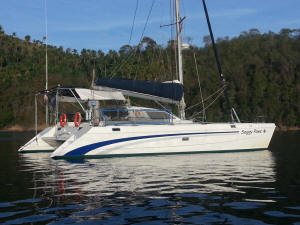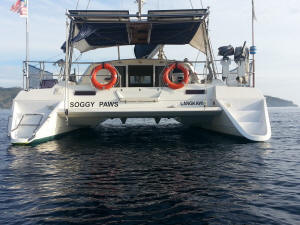|
St Francis |
|

About S/V Soggy Paws
St. Francis 44 MK II
 |
|||||||||
|
Hull# ZA-XGF44038K203 We purchased Soggy Paws (ex Bluemoon) in June 2015 from a family who had purchased her in South Africa and cruised to Southeast Asia. Bluemoon was in good condition and well-equipped for extended cruising, but we still felt we needed to do a few things. For those of you that like to make improvements to your excellent St Francis 44, below find a few ideas from our work over the past 3 years: Cockpit Upgrades When we bought Soggy Paws, the cockpit had a flat Sunbrella top over a nice stainless steel frame. The problem was, when it rained, water would pool directly over the helm seat, and drip profusely right on the helmsperson's head. There was only a narrow wooden walkway to get to the aft end of the boom. And there was no water catchment system built in. So we had a hard fiberglass top made. Then we added side drop down spray shields so we can fully enclose the front and sides of the cockpit in foul weather. We also replaced the flimsy helm-seat-on-a-pedestal with a custom-made rectangular fiberglass helm seat sized for two, with several cabinets inside. Seated on this seat, we can see all 4 corners of the boat and work the main sheet and traveler. We added two smaller winches behind the primary winches to be able to use a winch to reef the jib. Details on these upgrades are found on the Cockpit page. Hull Extensions The aft ends of the original hulls ended in a relatively small platform step that was constantly wet and grew green slippery slime. In order to prevent this we decided to raise the aft sections to the second step up and then extend them back to meet the underbody. This extended the hulls about 18" and raised the now 24"x48" aft platforms about 8" off the water. The extensions are made of strongly fiberglass reinforced 1" honeycomb and PVC foam. In order to get a thru-bolted folding SS ladder mounted, and provide access to the interiors, we installed 10" round hatches in each platform to allow access to the nuts inside. Benefits include a dry large swim platform with ladder access from the water, increased buoyancy aft which helps support the davit hung dinghy, and better access from a dinghy to the boat. Watermaker For many reasons, including the relatively small fresh water tankage on the boat, we finished off the mechanically driven 40 gph watermaker that the original owner had mostly completed. It includes a HyPro 4.8 gpm triplex HP plunger pump, dual 2540 membranes, a Marsh centrifugal boost pump and assorted valves, gauges and flowmeters. See Workshop/Plumbing for details. Refrigeration We have upgraded both the refrigerator and freezer on the St. Francis 44. The original 2.5 cubic ft RV refrigerator installed in the front of the galley was way too small for the style of cruising we do. So we replaced it with a custom made 8 cubic ft front-opening refigerator with good insulation. The factory-installed Minus 40 freezer is top loading and with about 4 cubic ft of interior volume. It is a nice unit, but we felt the BD35 air-cooled compressor was a little small. So we replaced the BD35 with the bigger BD50 with a Frigoboat keel cooler. Marrying the Frigoboat system to the original evaporator plate under the SS interior wasn�t easy and required some refrigerant plumbing silver solder work. It now uses about 60 aHrs a day, mainly because of its less-than-optimal insulation. Check out our Refrigeration page for more details on these upgrades. Engines and Saildrives We have done a number of major maintenance items and upgrades with the engines and saildrives, including:
See everything we have done to maintain and upgrade our saildrives on the Engines and Saildrives page. Electrical System We replaced the original solar panels and solar controllers with 4 new monocrystaline 200-watt panels and an 60-amp Morningstar Tristar MPPT solar controller. The solar panels are strongly mounted flat on standard solar panel aluminum rails with their feet imbedded in our cockpit hard top. We upgraded the alternators with two common automotive 60 amp externally-regulated units. Each is equipped with a Wakespeed 500 very smart alternator regulator. Because of our Lithium battery system they are detuned to 75% of their max output, and have thermal monitoring by the Wakespeed. They are protected from spikes with Balmar alternator protection devices. During our COVID time (locked down in the Philippines), we spent a considerable amount of time rewiring the major wiring on the boat. We also replaced our 13 year old (but still fine) Sonneschein gel batteries with LifePO4 cells. The new system is a DIY affair with 540 aHrs of prismatic cells in a compression box, ElectroDacus SBMS0 external relay BMS, a Node Red display and various relays and other electric devices required for the system. The single 700 CCA SLA start battery is charged off the house bank through a thermal circuit breaker and diode. See the details of the electrical system upgrades on our Electrical Systems page. Interior We have made a number of upgrades to the interior
See the details on our Interior page. Other Improvements Installed a small stand-alone navigation mini-computer with a 20 inch display. Installed a B & G Halo 24nm radar that displays on our navigation computer so no expensive separate radar display needed. Installed an Icom 802 HF radio for long range communications with friends. Installed a Gen 2 Starlink satellite communications system. Brought the Code 0 sail from our monohull aboard and made a custom prodder for it. Installed new main cabin EVA faux teak flooring to replace the old carpet. Installed an Amseco SSX-52S weatherproof siren/strobe alarm system that can be activated from our bunk in case of an emergency. Installed a Garmin GPSmap 526s full function small chart plotter with bottom scanning sonar at the helm station. The sonar along and OpenCPN with satellite imagery allows us to effectively map the bottom for anchoring. The OpenCPN ensures we have an accurate location and shoreline display in remote locations. For improved dinghy propulsion we purchased an ePropulsion Spirit 1.0 Plus electric outboard motor. With full charge, it will run 6 hours at about 3-4 knots and is rechargeable from our small inverter or 12v. The motor/shaft and battery each weigh about 20 lbs so it is easy to carry the battery inside for charging while leaving the motor on the dinghy. It is super quiet and adequate for about 80% of our dinghy use. It is really useful for exploring up rivers without disturbing the wildlife. No more noise, smoke, and gas/oil mixing. From our previous boat, subjects that apply to the current boat:
|
|||||||||
Copyright 2024
WebDesignsInternational

